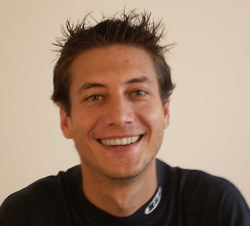Dr. Javier Minguez
The Wired article A Wheelchair That Reads Your Mind said
“Patients who suffer from disease or injury that leave them unable to move have little hope of independent mobility. But that may be about to change. Researchers are developing a thought-controlled robotic wheelchair.Spanish scientists have begun work on a new brain-computer interface, or BCI, capable of converting thought into commands that a wheelchair can execute.
The Spanish researchers hope to develop a small, mobile interface that works with electroencephalogram electrodes, or EEG, placed on the scalp.
‘We are planning to use non-invasive devices to record the rhythms from the surface of the skull,’ says Javier Minguez, a researcher at the University of Zaragoza in Spain. ‘We also plan to use this system with a school for disabled children that we collaborate with and we prefer to use non-invasive techniques with these children.’”
Javier Minguez, Ph.D. is Ramón y Cajal researcher at the Computer Science and Systems Engineering of the University of Zaragoza, Spain. Javier is conducting research in Mobile Robots with an special interest in obstacle avoidance, architectures for sensor based motion planning, motion estimation, local mapping, and human robot interaction.
Javier coauthored The Ego-Dynamic Space (EDS): Dynamics of the Vehicle, Sensor-Based Robot Motion Generation in Unknown, Dynamic and Troublesome Scenario, Modeling the Static and the Dynamic Parts of the Environment to Improve Sensor-based Navigation, Probabilistic Scan Matching for Motion Estimation in Unstructured Environments, Nearness Diagram Navigation (ND): A new Real Time Collision Avoidance Approach, and 3D Mapping for Mobile Robots using Interactive Virtual Worlds and Internet Teleoperation. Read the full list of his publications!
In 2002, he earned a Ph.D. in Computer Science and Systems Engineering from the Universidad de Zaragoz with the thesis Robot Shape, Kinematics and Dynamics in Sensor-Based Motion Planning. He earned a MSc in Physics from the Universidad Complutense de Madrid in 1996.
